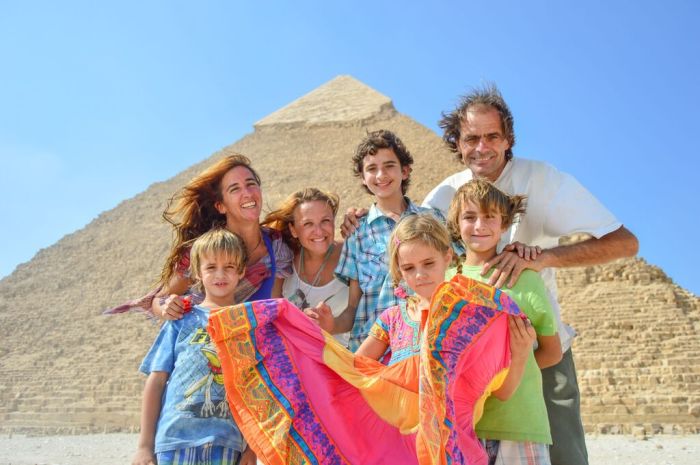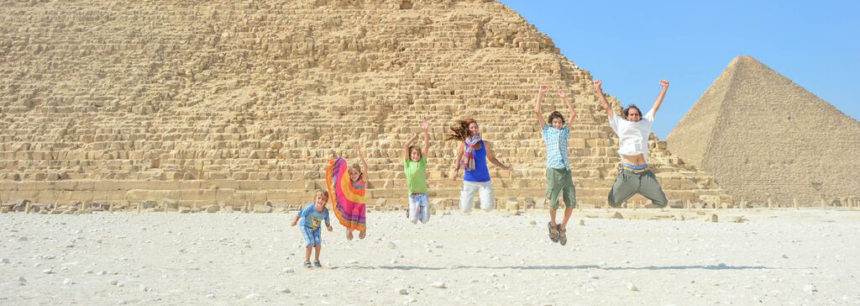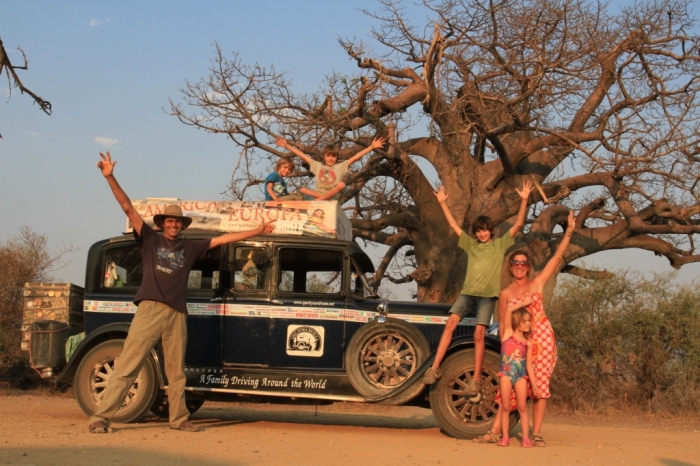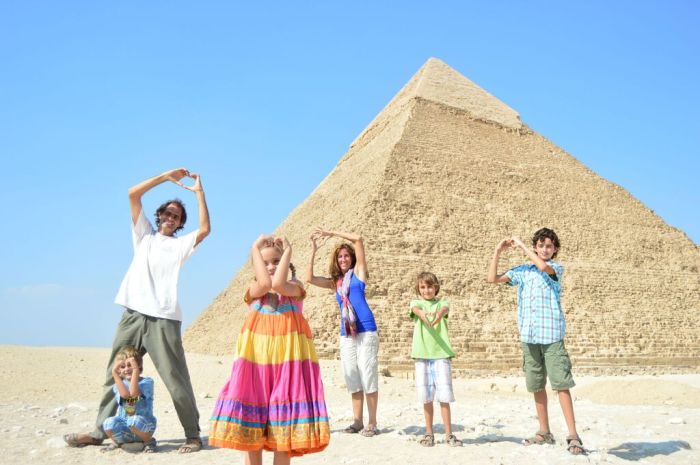It’s 4pm. The sun is merciless and the sand itches, but Herman Zapp and his family do not spare a minute. It’s been seven hours since they arrived to the pyramids and they keep exploring them throughout, inside and around. Suddenly, Herman stops. He leaves his backpack on the floor, opens his arms wide and hugs the 136-metre pyramid of Khafre. He stays there, motionless, his cheeks against the hot yellow stone. “Do you feel it?” He asks his wife.
That’s Herman. A man whose vibrating passion seeps out through his every word, an Argentine traveler who decided to leave his job, his house, and his routine behind to embark on a journey around the world with his wife in an 87-year old vintage car. One day, 15 years after the moment he started the engine, he realised the trip had become their life; “because dreams are there to be lived, not to be reached,” he says.
A couple of metres away, under the shadow of the pyramids, their son Pampa and I are absorbed in conversation. “Every time I meet a person, I ask them the same question: If you had the magic lamp, which are the three wishes you would make?” asks the 13-year old child. His peculiar name mimics the plains that stretch through his parents’ homeland in Argentina, a vast area called La Pampa where nothing but fields of wheat and soy stand. Just like Pampa, his siblings were all born on the road in different continents: Tehue, in Argentina, their sister Paloma in Canada, and Wallaby in Australia, home to the small kangaroos that inspired his name.
Their visit to Egypt is the last stop of a three-year-long tour across Africa, a road trip that began in Cape Town and ended in Alexandria, linking the Southern-most point of the African Continent where the Atlantic meets the Indian Ocean, with the Mediterranean Sea at the northern-most part. The 1928 Graham Page that has taken them across over 250,000 kilometres has its own name, surname and passport, a document which is stamped every time they cross the borders into a new country. “The car is called Macondo Cambalache, a mixture between the famous place portrayed in Gabriel Garcia Marquez’s 100 Years of Solitude – a tiny town where the craziest things could happen – and a beautiful Tango,” Herman explains.
Travelling at 60 kilometres per hour is not a problem for the dream team, who take enough time to breathe in the cultures and let every inch of the landscape engraved in their memory. African red deserts, green north-American lakes, the forests of Japan, and the 5,230 metres of Tibet have all been unforgettable grounds for the family to spend the night on the wonder-sparking car, which they customised adding an extra row of seats, a tent on the roof, and a small kitchen at the back.
Their first adventure was a 70,000 kilometre long journey from Argentina to Alaska, a dream they conceived as Candelaria and Herman started dating, when she was 14 and he was 16 years old. “What we never imagined is that we would extend it for 15 years and have four kids on the way,” Herman says. Born in the USA to a German father and an Argentinian mother, Herman grew up in the Argentine countryside, where he met his wife Candelaria when he was eight-years old. After they got married and bought their house, they decided to pursue their life-long dream and travel the three American continents.
Going down the Amazon River in a raft, running out of money and selling water colors to pay the expenses, and having their first son along the way were only a few of the challenges the intrepid couple faced. But as the trip was over and their dream was accomplished, they realised that the best part of the journey was not the places they had seen, but the people that hosted them and helped them along the way. “They opened their hearts to us, and shared a big treasure: their families, their homes,” Herman says. “Another mountain after a thousand mountains is just another mountain. Another beach after a thousand beaches is just another beach… but the person we meet is unique; that’s what counts, and that’s why our dream kept growing.”
Far from staying at hotels and resorts, Herman and Candelaria have always stayed at family homes, where they have spent 4,000 nights in the 15 years since they set off from Argentina. After their return from Alaska, they published their book Atrapa tu Sueño (Spark your Dream) which became a best-seller in Argentina in 2005, selling 55,000 copies in Spanish and six editions of the English version, published in 2007.
But it was not long until the family set off on a third trip across Asia and Oceania, where their fourth son, Wallaby, was born. “Having a child on the road was not easy the first time,” says Candelaria, who used to carry a mobile medical record for international doctors to follow her pregnancy’s steps. “I was afraid, I was nervous, but people used to tell me not to worry; I was not sick but going through a natural process,” she recalls.
“I remember the first time I was pregnant and we were in the Amazons. Children are born all the time there! So I thought: it is worse to do it when you are stressed, having to work, running routine and errands, or while doing what you love, enjoying it 24 hours a day, and in the company of your husband?,” she says, a big smile framing her face. Having to pay for scans with paintings, bartering, or a book, the Zapp’s births were not spared of adventure: two deliveries were held at their hosting houses, while in Australia, a small swimming pool served as the setting for a natural birth. As she recalls her adventures as a pregnant traveler, Candelaria shows me her mobile school, a massive leather box carrying the books she uses to teach her four children the official syllabus sent through the Argentine embassy.
Three years ago, as the Asian trip came to an end, the restless family shipped the car from India to South Africa and started their African tour, which took twice as long as they had expected. “In South Africa, we had thought of staying for three months and ended up staying for a whole year. People in Africa are very open, we went from camp to camp,” says Candelaria. Diamond divers, small-plane pilots, farmers, bishops and nuns, collectors of steam train and cars, restorers, vineyards, farms, Zulu houses, or farms with wild animals: all of them opened up their houses across Africa to receive the travelling family.
“We sometimes get stuck but we look for ways to keep in motion. Even if it is hot, even if some of the sand returns back into the pit when shoveling it, even if it takes more time and effort than expected, even when there are lions around… we do it to keep moving and see more ways of living life. We see different people, and a variety cultures; and then realise the different ways of being happy,” she says.

Some people would call them crazy, but the couple’s itch for discovering and their insatiable dream to explore the world seemed, to Herman, the most reasonable reason to head off. “There are difficult days, but I prefer one bad day in my dream than any other day outside of my dream. I can assure you that every day counts, life is fully lived,” he says. “In one week, I have enough stories to write a whole chapter for a book; but before, perhaps years would pass by and I would have nothing to tell, not even to write one page.”

It’s 11.30pm and we have just finished dinner. Candelaria is packing the two suitcases they carry on the tent sitting on the roof of the old Graham, as Herman goes downstairs to repair the spare wheels for old car. “People ask us why we are doing what we are doing,” he says. “And we love to ask in return: why are you not doing it? I mean, how can you not go for your dream? It should be the most normal thing to do to go for you dream. You know that the opposite of love is hate, and the opposite of day is night; but tell me: what’s the opposite of dream? I think about it and I can’t find it. There is no such thing, there is nothing and no one against your dream… the odds are with you,” he says as he thinks about his next destination: the European continent.
Follow the family as they travel the world on their Facebook page.
This article was originally published at www.cairoscene.com. Photography by Ahmed Tarek.








Leave a Reply